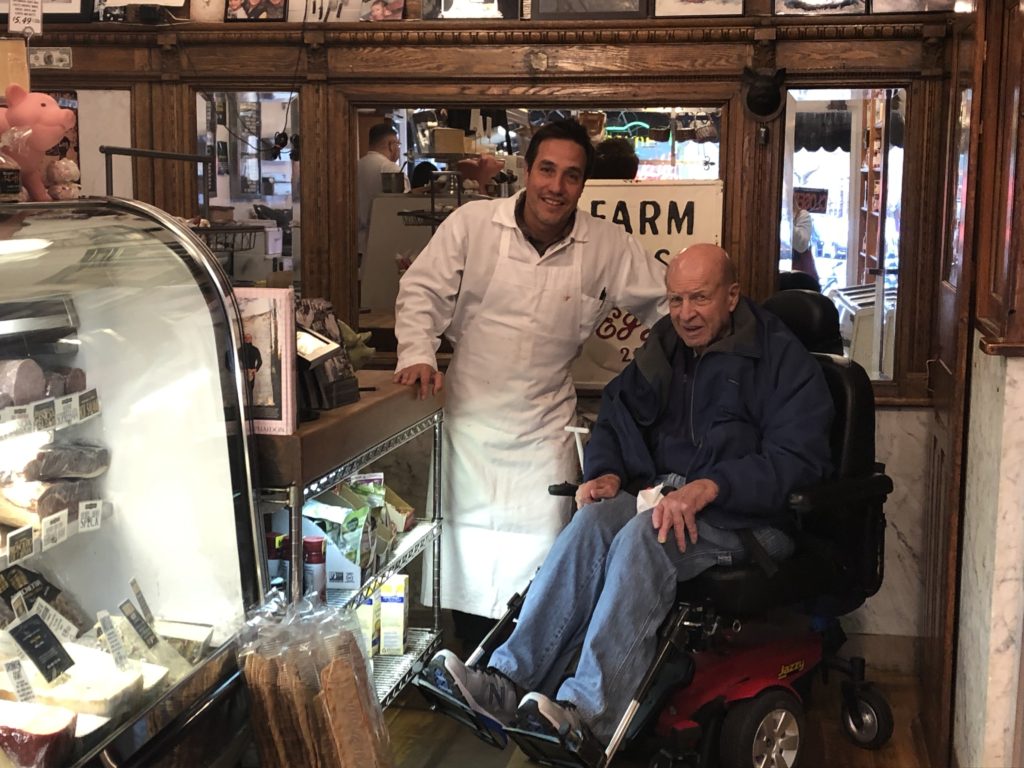
John McFadden Jr., owner of Staubitz Market—the oldest butcher store in New York City—sits in a Thai restaurant in Cobble Hill, across the street from his shop, scooping emerald curried chicken onto a mound of rice. He takes a sip from a tall glass of Thai iced tea. “I eat an inordinate amount of Thai food. I get it delivered quite frequently at work, where I eat in the store room or on the fly due to my busy schedule.”
His father, John Sr., bought the business in 1967 from Martin Lang, the store’s second owner. Eighty-three-year-old John Sr. ran the store until he fell down the stairs in his home last year, but still comes in every day to check in, navigating his wheelchair up a special ramp. He sits at the rear of the shop, making sure that everything is done to his standards, bickering with his son about how many products to put on the shelves.
“My father wants it all his way. His way or the highway. We argue and butt heads, but for the most part we are on the same track. We both value a high level of customer service, a great product, and a reasonable price. We both love the tradition of Staubitz and carrying it forward,” he said. “However sometimes he doesn’t understand why I want to tweak things that he remembers a certain way.”
“I took a trip to Europe 30years ago and saw that the butcher shops had rotisserie chickens. I came back to the U.S. so excited, and was like: Dad I got this great idea. Let’s have a rotisserie! And he was like, nope!” He chuckled. “Ten years later some guy opens up down the block with this massive rotisserie unit. He was selling around 300 chickens a week! I was so mad!”
John started to work for his father at eleven, sweeping the floors. “After my first day, my mother came to the door and asked me how it was, and I said I hated it and didn’t want to go back. I went upstairs and passed out.
He learned butchering from his father, who trained for four years to be a master butcher. “As you get older, you’re handling a knife more and more, and then you’re developing the musculature for that hand and eye coordination,” said John Jr. After high school, he was accepted to college but did not go. “I was making money, had a nice life style, I was traveling. I never thought I wanted to be a butcher, it just happened, and I found myself doing it full time.”

John drums his knuckles on the inventory checklist as his head bobs to a playlist that ranges from Justin Bieber to Aerosmith. The antique screen door slams shut. To the left, a sixty-year-old showcase displays meat and artisanal cheeses. Photos of the shop dating back to 1917 hang on the walls. To the right, shelves hold an array of specialty items, from ghee to Kosciusko brown mustard. An original cashier booth at the rear of the shop is laden with accolades. Daphne the Killer, the market cat, sniffs the new deliveries.
While the playlist might be modern, the operation is not: John Jr. sticks with the traditional methods of a 19thcentury butcher shop. He hand-selects the meat hanging from hooks at a local warehouse a couple times a month—a practice that is almost extinct due to the “one-factory processing” model, where slaughtering to packaging take place in one building, allowing most butchers to get their meat shipped in boxes. “Staubitz has always been a high end shop, so everything we do is prime. I look for a high rate of marbleizing, meat to fat ratios, coloring, size, and proportion,” he said.
“Unfortunately, there’s no more customer loyalty. You have to know that back in the day, people were extremely loyal to the shops they went to. There used to be chairs here for people to sit and wait, because everything cut to order.” John still has a core of loyal customers, but as they get older, convenience matters more: If people are near a Whole Foods, he says, they will shop there.
He tries to meet the needs of contemporary customers. “We’re at a crucial point where we are seeing we have to make adjustments,” he says. “We have to start bringing in prepared foods because that’s what people want. I’ll initially buy foods like sandwiches and potato salad, and sell them to see what the demand is. If it works, it may be worth for us to invest in our own commercial kitchen.”
John accepts the reality that his son, who is thirteen years old, might not take on the family business. “Things are different now. When I went to school, I had the whole afternoon to hang out with friends,” he says. “My son doesn’t get home from school until six due to sports, and then has to do homework. He doesn’t have time to come to the store.” He is very excited for Aiden, who is going to high school next fall and is interested incomposing rap songs and acting. John and his wife, Christine Kim, encourage Aiden by taking him to auditions around the city.
“At this point I’m 52. I figure I’ve got a good 15-20 years left to be in a position where I can work.” He is unsure of what will happen with the business when he’s ready to stop.
John finished his curry and paid for lunch in cash. Despite the history of his store and its demands, he has the autonomy he values. “In the end, I Just do what I want anyways. Like my father always said, it’s easier to ask for an apology than permission.”

Your Comments